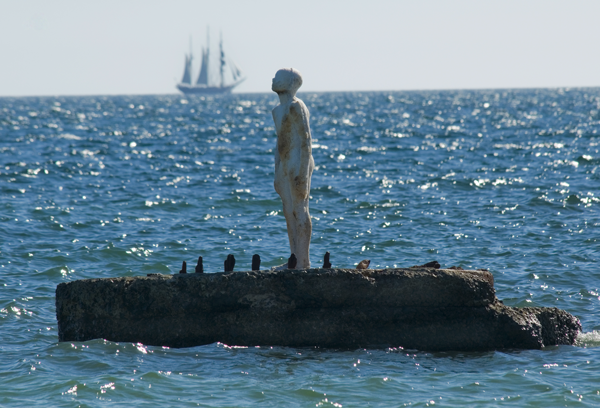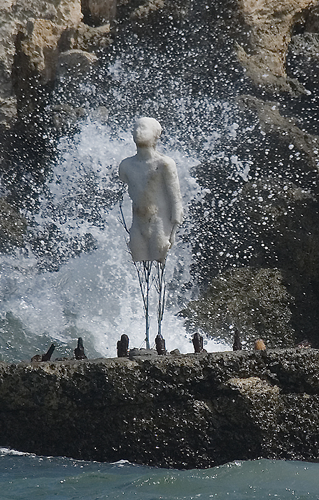Simon Gilby with text co-written by Dave Whish Wilson
All images are of Entitlement 1, Bathers Beach, Fremantle, salt and stainless steel, 61″ tall. Photos by Rooel Loopers.
There is an ethereal quality to Simon Gilby’s salt figure, cast from the body of a ten year old boy, which speaks of its materiality, positioning and transformative properties. Bolted onto a small concrete island, an abandoned gun turret at Bathers Beach, Fremantle, the salt-boy stands as both metaphorical invitation and physical representation; a creature of sensual connection as much as of matter.

In its muteness and mutability, from the moment of its placement the figure was responsive to its material conditions, albeit silent in its response, and in silence inviting response. Sculpted in the human form, with its feet in the sea-spray; a heat-forged figure licked by the tongues of waves, baked by the sun and burned by the wind, amid the vast oceanic language of unconscious meaning and godlike scale, the salt-boy returns to this language and this source.
His is an ambulatory form whose temporal passage and elemental subjectivity invokes a complexity of experience, in particular around notions of dissolution and decay, of departure and return, of essence and connection. He stands at the very site of the liminal and the littoral, speaking to both the limiting possibilities of a patrolled border, and a more illuminating potential as a site of immersive understanding.
In light of the work’s title, it is a considered placement, shrouded in its vigil silence, on an island of its own, at the entry point of white settlement. By Gilby’s description, the salt figure is a totem of elemental humanity, stateless and vulnerable prior to the ascription of rights and entitlements according to accidents of birth. But what is the figure entitled to, by virtue of its placement, on an island of its own? And what, the artist asks, are our own entitlements, and how did we come by them?

To this end, the work resonates with particular meaning in the context of our nation’s asylum seeker policy, and the recognition that our first nations people aren’t, by virtue of their location or placement, entitled to the same services as other Australians.
Salt is both the defining matter of the ocean, and an ancient remnant of the once-hinterland seas. In its suspension in the former, salt water is always mobile, subject to oceanic current and tidal flux. In its manifestation of the latter, the primeval sea-beds of inland Australia; salt is both static and buried, until disturbed, when it rises to the surface and poisons the land. In between these two possibilities is the invisibly air-born; salt that can be tasted on the wind, settles on the land, on the skin. In this way, the image of the salt-boy speaks both to the motility of the material and the instability of the boundaries between land and sea, stone and water, conscious and unconscious, self and other.

For more than 100 days the artwork’s poetic transfiguration from human form to remnant tree invoked the life-cycle of the sculpture’s immediate environment, situated in one of the world’s most ancient, bio-diverse, but fragile eco-systems. In this sense, the erosion of the human form by the natural elements of wind and water is a patient and startling revelation of an original material condition. It speaks to a return to source, hinting in the process at the transmigration of human materials, in particular the toxic flushing of invisible micro-plastics and other waste-products into the ocean.
This representation of first principles, in essence the depiction of a landscape absent of the human figure, is suggestive of both the brevity of the human lifespan in relation to the location’s longer historical reality (which existed in a state of botanical quarantine for some hundred million years before human arrival) and a devastating image of a potential future encompassing climate-change and oceanic pollution.
Entitlement 1, by this reading, also hints at the primary existential feeling of a solitary and vulnerable figure, whose transubstantiation into a more ancient and enduring life-form ultimately reflects a broader and deeper societal and environmental malaise, holding up a mirror to what might be lost. Stoic or static, the salt boy invites responses that might be hopeful, might be real.

NOTE: Simon Gilby’s work Entitlement 1 was initially displayed as part of the exhibition, ‘sculpture@Bathers‘ 2015 and has remained in situ for more than 120 days.
David Whish-Wilson is a novelist, essayist and reviewer whose most recent publication is the Perth book in the NewSouth Books city series. His next novel, Old Scores, will be published by Fremantle Press in 2016. He lives in Fremantle, and coordinates the creative writing program at Curtin University.
Simon Gilby is an artist living and working in Fremantle WA, his work is represented in both public and private collections. His sculptures have been commissioned for major public artworks and he currently teaches at UWA. www.simongilby.com.au